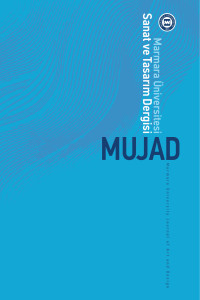Biliş, Bilişsel Bilim ve Tasarım Üçgeninde Yaratıcılık
Tasarım karmaşık ve çok boyutlu bir aktivitedir ve özellikle tasarım pratikleri içerisinde yaygın olarak; yorumlama, iletişim, problem çerçeveleme, araştırma ve bilgi entegrasyonu gibi çeşitli beceri ve eğilimleri içerdiği, karmaşık ve çok boyutlu bir aktivite olduğu kabul edilir. Tasarım temel olarak zihinsel, temsili ve insan zekasının bir göstergesidir ve tipik bir bilişsel süreç olarak ele alınır. Bu çalışma öncelikle bilişsel bir süreç olarak kabul edilen tasarımın bilim ile ilişkili olarak nasıl incelendiğini araştırmaktadır ve bilim ve tasarım perspektifinden bakıldığında bilişsel bilim ile tasarım bilişinin kesişimlerini ortaya koymaktadır. İkinci olarak literatürün yorumlanması ile açığa çıkan tasarım sürecinin günümüzde yaratıcı oluş üzerinden ele alınarak nasıl değerlendirildiğini örneklendirmektedir. Çalışma; günümüzde tasarım bilişi ile ilgili araştırmaların yaratıcılığı merkez noktası alan çok yönlü bir bakışa ihtiyaç duymakta olduğunu göstermiştir.
Anahtar Kelimeler:
biliş, bilişsel bilim, tasarım, yaratıcılık, tasarım bilişi
___
- Bermúdez, J. L. (2014). Cognitive Science: An Introduction to the science of the mind. New York: Cambridge University Press.
- Bonnardel, N. (2000). Towards understanding and supporting creativity in design: analogies in a constrained cognitive environment. Knowledge-Based Systems, 13 (7-8), 505-513.
- Brawne, M. (2003). Architectural thought: the design process and the expectant eye. Architectural Press.
- Buchanan, R. (1992). Wicked problems in design thinking. Design Issues, 8(2), 5-21.
- Cross, N. (1993). A history of design methodology. In de Vries, M.J., Cross, N., Grant, D.P. (Eds), Design Methodology and Relationships with Science (pp. 15-27). NATO ASI Series, vol 71. Springer, Dordrecht. https://doi.org/10.1007/978-94-015-8220-9_2
- Cross, N. (1999). Natural intelligence in design. Design Studies, 20(1), 25-39. https://doi.org/10.1016/S0142-694X(98)00026-X
- Cross, N. (2001). Designerly ways of knowing: Design discipline versus design Science. Design Issues, 17(3), 49-55.
- Cross, N. (2006). Designerly Ways of Knowing (pp. 1-13). Springer. http://dx.doi.org/10.1007/1-84628-301-9
- Eastman, C. (2001). New directions in design cognition: studies of representation and recall. In Eastman, Charles M., W. Michael McCracken&Wendy C. Newstetter Design knowing and learning: Cognition in design education (pp. 147-198). Elsevier.
- Freedberg, D., & Gallese, V. (2011). Motion, emotion and empathy in esthetic experience. In M. F. Gage, Aesthetic theory: Essential texts for architecture and design (pp. 309-323). W.W.Norton&Company.
- Gardner, H. (1985). The mind's new science: A history of the cognitive revolution. Basic Books Inc. Publishers.
- Goel, V., & Pirolli, P. (1992). The structure of design problem Spaces. Cognitive Science, 16(3), 395-429.
- Kahvecioğlu, N. P. (2007). Architectural design studio organization and creativity. ITU A|Z, 4(2), 6-26.
- Kirby, M. (1969). The aesthetics of the avant-garde. The art of time (pp. 35-64). Dutton.
- Oxford University Press. (n.d.). Internet addiction. In Oxford English Dictionary. Retrieved March 20,2023, from https://www.oxfordlearnersdictionaries.com/definition/academic/design1?q=design
- Plowright, P. D. (2014). Revealing architectural design: Methods, frameworks and tools. Routledge.
- Shapiro, L. (2011). Embodied cognition. Routledge.
- Suwa, M., Gero, J., & Purcell, T. (2000). Unexpected discoveries and s-inventions of design requirements: Important vehicles for a design process. Design Studies, 21(6), 539-567.
- Takala, T. (1993). A neuropsychologically-based approach to creativity. In J. S. Gero, & M. L. Maher, Modeling, creativity and knowledge-based creative design (pp. 91-108). Lawrence Erbaum Associates.
- Türk Dil Kurumu (TDK). Internet addiction. In Türk Dil Kurumu Sözlükleri. Retrieved March 30, 2023, from https://sozluk.gov.tr/
- Vermaas, P.E., 2014. Design theories, models and their testing: on the scientific status of design research. In: A. Chakrabarti and L.T.M. Blessing, (Eds.), An anthology of theories and models of design: Philosophy, approaches and empirical explorations (pp. 47-66). Springer.
- Thagard, P. (2008). Cognitive science [Internet]. Stanford Encyclopedia of Philosophy. Retrieved March 29, 2023, from https://plato.stanford.edu/entries/cognitive-science.
- Yayın Aralığı: Yılda 2 Sayı
- Başlangıç: 2023
- Yayıncı: Marmara Üniversitesi
Sayıdaki Diğer Makaleler
Animasyon Sineması: Tarih, Kuram, Uygulama
Arkeolojinin Arayüzünde Çalışan Sanat: “Yokluğun Karmaşık Sorunları ve Boşluk: 4. Katman”
Çağdaş Fotoğraf Sanatında Gözetim ve Mahremiyetin Teşhiri: Michael Wolf Örneği
Uluslararası İlişkiler Bağlamında Türkiye Balkan Ülkeleri Temalı Filatelik Tasarımların Analizi
Dünden Bugüne Grafik Tasarım Mesleği ve İsimlendirme Sorunsalına Bakış
Tek Mekânda Geçen Tek Kişili Filmlerin Anlatım Biçimi
Yapay Zekâ Estetiği ve İnsan Merkezli Yaratıcılık Miti
Emanuele ARIELLI, Lev MANOVICH, Çevirmen: Kerem Ozan BAYRAKTAR
Ai Weiwei ve Antony Gormley’in Seramik Enstalasyonlarında Tektipleşme
